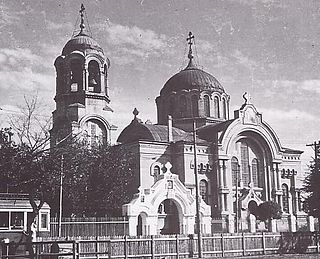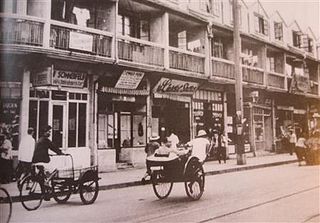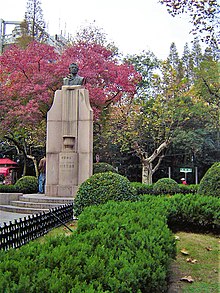
Harbin is the capital of Heilongjiang, China. It is the largest city of Heilongjiang, as well as being the city with the second-largest urban population and largest metropolitan population in Northeast China. Harbin has direct jurisdiction over nine metropolitan districts, two county-level cities and seven counties, and is the eighth most populous Chinese city according to the 2020 census. The built-up area of Harbin had 5,841,929 inhabitants, while the total metropolitan population was up to 10,009,854, making it one of the 100 largest urban areas in the world.
The history of the Jews in China goes back to ancient times. Modern-day Jews in China are predominantly composed of Sephardic Jews and their descendants. Other Jewish ethnic divisions are also represented, including Ashkenazi Jews, Mizrahi Jews and a number of converts to Judaism.

The term Harbin Russians or Russian Harbinites refers to several generations of Russians who lived in the city of Harbin, Heilongjiang, China. Russian settlers were responsible for turning Harbin into a Russian city with the majority of the population being from Russian ethnic groups, from approximately 1898 to the mid-1960s. Harbin, a major junction city on the Chinese Eastern Railway (CER), came successively under the control of the Qing dynasty, under Russia's sphere of influence, the Republic of China, Japanese puppet state Manchukuo and the People's Republic of China in this period.
Amleto Vespa was an Italian mercenary and secret agent of Italian origin, who worked in Manchuria from 1922 to 1940, first for a local warlord, and then for the Empire of Japan. A self-proclaimed fascist and an admirer of Benito Mussolini, Vespa had no admiration for the Japanese administration of Manchukuo, which he described with considerable venom in a book published in 1938.

The Shanghai Ghetto, formally known as the Restricted Sector for Stateless Refugees, was an area of approximately one square mile (2.6 km2) in the Hongkou district of Japanese-occupied Shanghai. The area included the community around the Ohel Moshe Synagogue. Shanghai was notable for a long period as the only place in the world that unconditionally offered refuge for Jews escaping from the Nazis. After the Japanese occupied all of Shanghai in 1941, the Japanese army forced about 23,000 of the city's Jewish refugees to be restricted or relocated to the Shanghai Ghetto from 1941 to 1945 by the Proclamation Concerning Restriction of Residence and Business of Stateless Refugees. It was one of the poorest and most crowded areas of the city. Local Jewish families and American Jewish charities aided them with shelter, food, and clothing. The Japanese authorities increasingly stepped up restrictions, surrounded the ghetto with barbed wire, and the local Chinese residents, whose living conditions were often as bad, did not leave. By 21 August 1941, the Japanese government closed Shanghai to Jewish immigration.

White Russian émigrés were Russians who emigrated from the territory of the former Russian Empire in the wake of the Russian Revolution (1917) and Russian Civil War (1917–1923), and who were in opposition to the revolutionary Bolshevik communist Russian political climate. Many White Russian émigrés participated in the White movement or supported it. The term is often broadly applied to anyone who may have left the country due to the change in regimes.

The Peking Legation Quarter was the area in Beijing (Peking), China where a number of foreign legations were located between 1861 and 1959. In the Chinese language, the area is known as Dong Jiaomin Xiang, which is the name of the hutong through the area. It is located in the Dongcheng District, immediately to the east of Tiananmen Square.
There are roughly 1,000 Armenians currently living in Mainland China and Hong Kong.
Simon Kaspé (1909–1933) was a Russian Jewish resident of Harbin, Manchuria who was kidnapped, ransomed, tortured, and murdered by a gang of fascist criminals under the influence of exiled White Russian leader Konstantin Rodzaevsky. The halfhearted investigation into his disappearance and death by the Japanese authorities, who were courting the White Russian community as local enforcers and fomenting their anticommunism, sparked anti-Japanese sentiment among the Jewish community of Manchukuo and the flight of nearly 70% of the Jews of Harbin.
Abraham Josevich Kaufman was a Russian-born medical doctor, community organizer and Zionist who helped protect some tens of thousands of Jews seeking safe-haven in East Asia from Nazi atrocities during World War II.

The Shanghai Jewish Refugees Museum is a museum commemorating the Jewish refugees who lived in Shanghai during World War II after fleeing Europe to escape the Holocaust. It is located at the former Ohel Moshe or Moishe Synagogue, in the Tilanqiao Historic Area of Hongkou district, Shanghai, China. The museum features documents, photographs, films, and personal items documenting the lives of some of the more than 20,000 Jewish residents of the Restricted Sector for Stateless Refugees, better known as the Shanghai Ghetto, during the Japanese occupation of Shanghai.

The Ohel Rachel Synagogue is a Jewish congregation and synagogue, located at 500 North Shaanxi Road, in the Jing'an District of Shanghai, China. Built by Sir Jacob Elias Sassoon in memory of his wife Rachel, it was completed in 1920 and consecrated in 1921. Ohel Rachel is the largest synagogue in the Far East, and one of the only two still standing in Shanghai. The congregation worships in the Sephardic rite.

The Beth Aharon Synagogue was a Sephardi synagogue in Shanghai, China, built in 1927 by the prominent businessman Silas Aaron Hardoon in memory of his father Aaron. During World War II, the synagogue provided refuge for the Mirrer yeshiva of Poland, the only Eastern European yeshiva to survive the Holocaust intact. After the establishment of the People's Republic of China, it was used by the Wenhui Bao newspaper and as a factory during the Cultural Revolution. It was demolished in 1985.

Israel's Messenger, also known in Chinese as Youtai Yuebao, was an English-language newspaper published in Shanghai from 1904 to 1941. It was established by N.E.B. Ezra, who served as the paper's Editor-in-Chief for more than 30 years until his death in 1936, as the official newspaper of the Shanghai Association. It was one of China's oldest and most sophisticated Jewish periodicals, which also influenced the Jewish press.

Nissim Elias Benjamin Ezra (1883–1936), commonly known as N.E.B. Ezra, was a Baghdadi Jewish publisher and Zionist based in Shanghai. He founded the Shanghai Zionist Association in 1903 and its official newspaper, Israel's Messenger, one of China's oldest and most sophisticated Jewish periodicals. He served as editor-in-chief of the newspaper for more than 30 years until his death in 1936. Influenced by Ezra, his nephews started the newspaper Jewish Tribune in Bombay, India.

The New Synagogue was a former Jewish congregation and synagogue, that was located at 102 rue Tenant de la Tour in the French Concession of Shanghai, China. The synagogue was opened in 1941 to serve the city's then growing Ashkenazi Russian Jewish community, and was closed in 1965 after the departure of most Jews from Shanghai following the Communist victory in China.

Haipai cuisine is a Western-style cooking that is unique to Shanghai, China. It absorbs the traditions of several cuisines from other regions of China and of Western cooking, adapting them to suit the local taste according to the features of local ingredients. It is divided into several major types: French, Italian, Russian, British, and German, among which the Russian-type dishes, such as the Shanghai-style borscht, receive a great welcome as they are more affordable. Today, the most famous dishes of Haipai cuisine are luó sòng tāng, fried pork chops, and Shanghai salad. Apart from the above-mentioned common dishes, baked clams, baked crabs, and jin bi duo soup are also popular among the Haipai dishes.

Lidiya Yulianovna Serebrova was a Russian poet and author. Khaindrova's family left the Russian Empire in the years immediately preceding the Russian Revolution and she lived in China from 1916 to 1947. In China, Khaindrova was involved in literary circles and published poems in magazines, journals and her own collections. Central themes in her work are the longing for home, the revolution, peace and war. In 1947 she moved to Russia, and she later worked as a proofreader and English teacher.
Ukrainians have been present in China since the early 18th century and have been a significant part of the Ukrainian national movement in the Far East. Historically holding a significant presence in Harbin, the Ukrainians of China saw a peak of political activity in the interwar and World War II before being effectively integrated into Chinese society in 1948. However, since Euromaidan, Ukrainians have once again begun to re-establish their unique identity in China.
Eugenia (Genia) Nobel was a communist and German Jew who fled to Shanghai during the Second World War. In Shanghai, she produced news programming and anti-Fascist propaganda for the Soviet TASS radio station. She was also a leading organizer of the Association of Democratic Germans in Shanghai, which helped around 500 Germans to repatriate in 1947. In East Germany, she was an expert for international relations, particularly with China, and she authored important policy articles. Throughout her life, she worked as a writer, editor, and translator.


![The cover of Vladimir Zhiganov [ru]'s album The Russians in Shanghai (1936) Russiansinshanghai01.jpg](http://upload.wikimedia.org/wikipedia/en/thumb/a/a9/Russiansinshanghai01.jpg/220px-Russiansinshanghai01.jpg)















